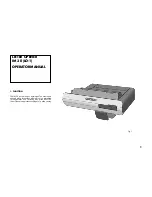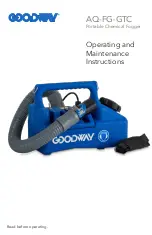
2-18
SAFETY DEVICES
There are certain safety devices on the IC-250 that are designed to maintain control of a
load even though power or hydraulic line failure should occur. The operator should
understand the function and operation of these devices so that a continual check on their
performance can be made.
OUTRIGGER CYLINDER CHECK VALVE:
A double-acting check valve is mounted on each of the outrigger cylinders. This valve holds
the outrigger in the extended position should power or hydraulic line failure occur. This valve
has no adjustment. If an outrigger creeps up while supporting a load, there is an internal
leak in the valve or in the outrigger cylinder piston seal. In either case, maintenance is
required.
BOOM ELEVATION CYLINDER HOLDING VALVE:
A single-acting holding valve is mounted on the cylinder barrel. This valve holds the boom in
the elevated position should power or hydraulic pressure line failure occur. This valve is
adjustable to hold the desired load. If the boom creeps down with loads up through
maximum capacity, this valve should be adjusted. If adjustment fails to correct the problem,
there is an internal leak in the holding valve or the hydraulic cylinder. Refer to the main-
tenance instructions.
BOOM TELESCOPE CYLINDER HOLDING VALVE:
A single-acting holding valve is mounted to the cylinder rod end. This valve holds the
cylinder in the extended position should power or hydraulic pressure line failure occur. This
valve is adjustable to hold the desired load. If the boom creeps in under load, this valve
should be adjusted. If adjustment fails to correct the problem, there is an internal leak in the
holding valve or the hydraulic cylinder. Refer to the maintenance instructions.
HOIST BRAKE AND HOLDING VALVE:
The hoist has an automatic brake in the gearbox and a holding valve mounted directly on the
hoist motor to hold the load. A clutch in the gearbox allows the winch to turn freely in the
RAISE direction. The brake is pilot released in the LOWER direction and should allow
smooth stops of a load on the hoist.
ANTI-TWO-BLOCK SYSTEM:
This system prevents damage to the hoist rope and machine components from accidentally
pulling the load hook against the boom tip. A pivot arm-actuated electric switch is connected
through a cable reel mounted on the boom to a solenoid dump valve in the hydraulic circuit.
This valve will dump the HOIST RAISE, TELESCOPE EXTEND and BOOM LOWER,
SWING LEFT and SWING RIGHT circuits. No other circuits are affected. These circuits are
returned to normal operation by operating the HOIST LOWER or TELESCOPE RETRACT
control. An emergency override switch is provided so the boom can be operated in case of
system failure. This key-operated switch is located under the left side of the instrument
panel.
W A R N I N G
We recommend the emergency override switch be used with discretion. Improper or
careless use of this switch can cause damage to the crane and endanger people and
property. The operator who uses this key in an emergency should use good judg-
ment.
W A R N I N G
Do not bypass safety devices! Each device has a specific purpose and should not be
tampered with. Death, serious injury, or property damage could result from a safety
device that is not functioning.
Summary of Contents for IC-250-3D
Page 6: ...1 2 IC 250 3D DIMENSIONS...
Page 7: ...1 3 IC 250 3D TURNING DIMENSIONS...
Page 16: ......
Page 30: ...2 14...
Page 42: ......
Page 51: ...3 9 IC 250 3D LUBRICATION CHART...
Page 58: ...3 16...
Page 59: ...3 17...
Page 68: ...3 26 BOOM CHAIN ADJUSTMENT...
Page 73: ......
















































